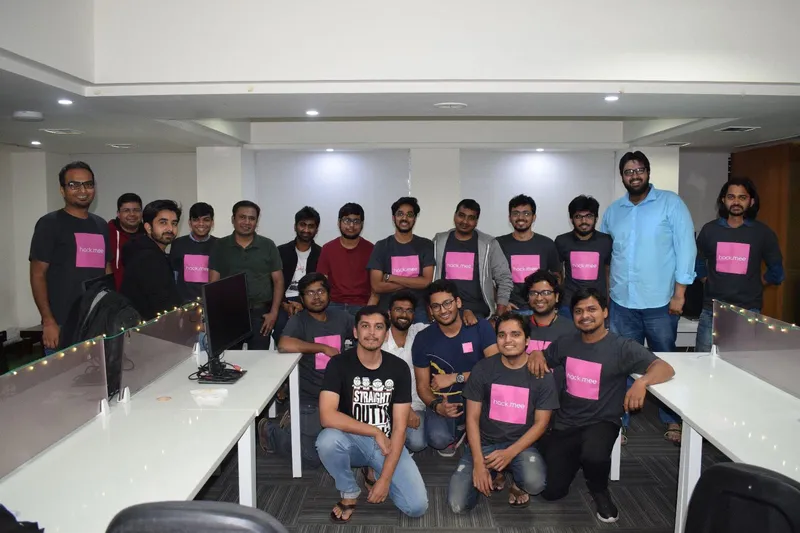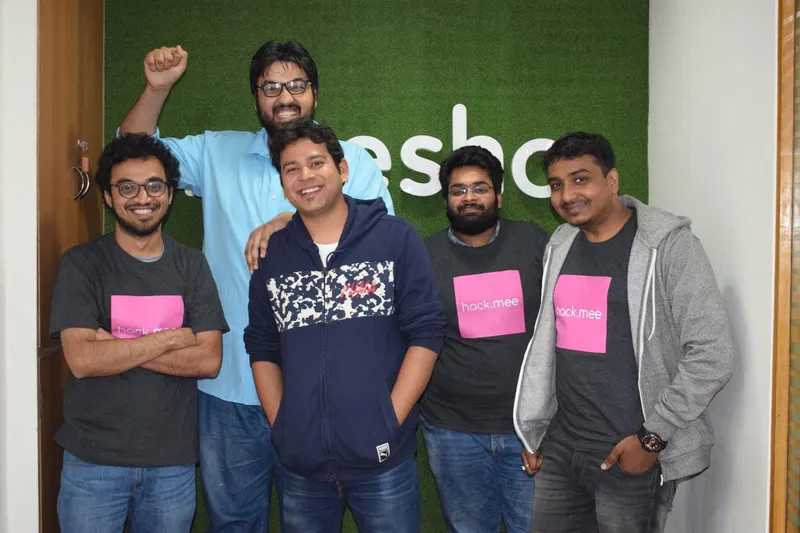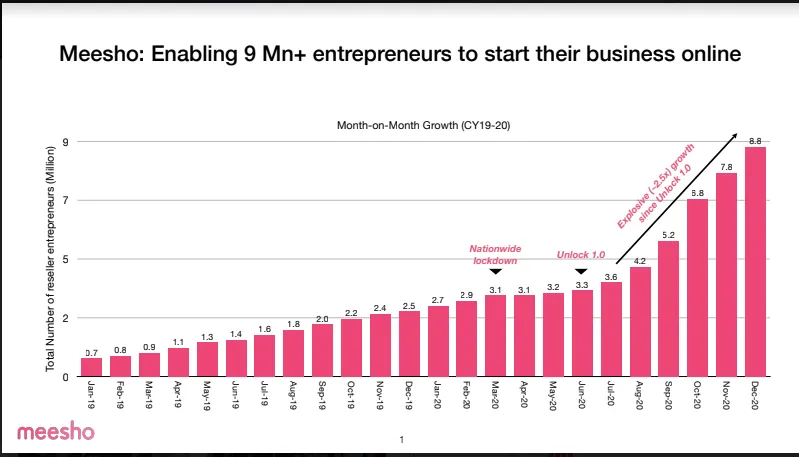[Product Roadmap] From being a ‘Swiggy for fashion’ to onboarding over 10M entrepreneurs, how Meesho cracked the social commerce model
In this week’s Product Roadmap, we feature Meesho, a social commerce startup that has onboarded over 10 million entrepreneurs across India.
In May 2015, Vidit Aatrey and Sanjeev Barnwal decided to take the plunge into entrepreneurship. They were looking to solve a difficult problem, but weren’t yet sure of the exact product or the market.
So, they looked at addressing the hyperlocal sector in the fashion industry and founded – a social commerce platform that empowers individuals to start an online business without capital. Meesho has enabled over 20 million customers and over 10 million entrepreneurs across India to sell on WhatsApp, , and Instagram by providing them products, logistics, and payment tools.

Meesho team
Today, Meesho is a Series D funded startup, with Facebook, Prosus (formerly known as Nasper), Elevation Capital (previously SAIF partners), Sequoia, Shunwei Capital, DST Partners, RPS Ventures, Venture Highway, and Y Combinator as investors. Also, former Vodafone CEO Sir Arun Sarin, KBE is an investor-advisor to Meesho.
The startup adds that close to 70 percent of these entrepreneurs are homemakers, career women on breaks, and students. Through this extensive trust network of social entrepreneurs, Meesho has created a disruptive supply channel for 50,000+ manufacturers/suppliers across the country.
ALSO READ

‘for fashion’
However, the product went through three different pivots before finalising on the current model. Explaining the journey, Sanjeev tells ,
“When you are a first-time entrepreneur, there are several areas you are looking to solve and address. We were also looking at areas that were getting funded. In 2015, hyperlocal was a hot sector so we thought why not build a platform that addressed the hyperlocal sector for fashion.”
The team built a ‘Swiggy for fashion’, where people had the option of selecting any product from the stores nearby, try them on, and then buy them. The team built an Android app and went live in parts of Bengaluru in 2015.
“It took us five weeks to build the app. And within two months of the launch, we realised that the people who were buying the products were our first and second-degree connections, and not beyond that. We realised that in fashion, the fundamental need is variety rather than the speed of delivery,” says Sanjeev.
He adds that in the first few months of the business, they focussed on iterating quickly and getting insights from users. “More than scale, it is about the speed of iterating and solving the problem quickly,” explains Sanjeev.
On the tech side, the team had started by building a monolith. Sanjeev says that managing a monolith is easier, especially when you have a small team. It helps scale to a certain extent. Today, Meesho has over 60 microservices and a monolith.
groups
Taking the learnings from the market, the team decided to quickly move to the next step. Since the team had connections with a few offline boutiques in HSR Layout and Koramangala in Bengaluru, the team decided to reach out to them and understand how they operated.
“When we asked them how they sold online, many said they were selling on WhatsApp. Whenever a consumer would visit the store, the store owners would add their number to a WhatsApp group. And whenever there was a new assortment of products, they would take pictures and share them on the group. That is when we were introduced to social commerce as a model,” says Sanjeev.
So, in October 2015, the team realised that the WhatsApp groups were an inefficient way of running a business, and the offline boutiques and stores were more than willing to go online.
“We pivoted and created something like a mobile version of Shopify for the Indian market. People can establish their own online presence, with domains such as abcboutique.meesho.com. They could share the inventory on the platform, and even had multiple payment options,” explains Sanjeev.
This was a fresh app, and the team realised that it was mostly homemakers with offline connections with suppliers in regions like Surat and Rajasthan who had started using the app to set up their boutique.
“It was interesting to see that we had built the app for someone else and a completely different target group adopted it,” adds Sanjeev. Since then, there has been no looking back, and many people started sharing the link of their Meesho pages on their Facebook and WhatsApp groups.

The Meesho Team
Meesho Supply
In the summer of 2016, Meesho was enrolled in the batch of Y-Combinator accelerator programme. By then, its product had already gained close to seven months of traction. It had all the basic features like inventory uploading, website, payment gateways, and integration with Facebook Apis to help create Facebook pages and group.
For the next several months, the team worked on improving the product, understanding what the user needed, and what would click with the end consumer. “It was in the last one-and-a-half months of the YC programme that we started seeing economic growth,” adds Sanjeev. They also raised a round of seed funding.
However, by October 2016, the team felt that while the app was on a high-growth trajectory, its retention wasn’t what they had expected. So, they went back to the users for feedback.
“They said that it was difficult to constantly keep finding new suppliers. Social commerce is about uniqueness and finding new products every time. You need a constant inflow of fresh products. For most homemakers, finding suppliers whom they can trust wasn’t easy. It is when we realised that it was a bigger problem than just setting up a storefront,” says Sanjeev.
It was then that they set up a team to work on a parallel product – Meesho Supply. The total team size was 20, and five of those focussed on the supply marketplace. The team started with Surat, which was a major hub for the manufacturing of fashion products, and found a few suppliers.
“To validate, we ran this on WhatsApp. We had a team of six people who got the catalogue of the suppliers and shared it on WhatsApp with the boutique owners. We made some minor hacks to make it more efficient to forward the catalogue to close to 500 people,” says Sanjeev. They had built a quick and dirty Android API that forwarded the catalogue quickly.

User growth
This led to Meesho creating a third app in January 2017. It had the basic features that the team had on the rudimentary WhatsApp group. On the app, people can select the catalogue and then share it on WhatsApp. If the customer wants to purchase a particular product, they can then come back to the app to place an order.
The team at Meesho built an integrated supply chain, with a small team coordinating the dispatches from Surat in the early days. From March 2017 onwards, the orders began doubling. The team raised a Series A round of $3.1 million in August 2017.
“By then, we also realised it didn’t make sense to focus on two different apps. We shut down the older app, and focused on the new one,” says Sanjeev. When they were building Meesho Supply, the team realised that most of their consumers were going to be from Tier I and II cities.
What works for the consumer
“We are building for people who aren’t as tech-savvy, and they were predominantly used to using WhatsApp and Facebook as their primary apps. Thus, the UX has to be extremely simple. More than design, simplicity is the primary focus. So you don’t hide things behind a ‘hamburger’ menu. Put everything upfront,” says Sanjeev.
The next focus of the team will be to ensure that the app can be used in areas where the network connection isn’t that stable. Sanjeev explains that this means there has to be aggressive caching, and focus more on the background to make it usable even in conditions where the bandwidth isn’t conducive.
“When entrepreneurs look at our catalogue, they want to share it with their customers on WhatsApp. So, we have optimisations to make sure that sharing takes minimum time or downloading images doesn’t take too long. In some cases, we cache these in advance – all based on rules and algorithms,” says Sanjeev.
However, when COVID-19 struck, the team saw a significant dip in user engagement. The team revamped their community, which enabled the users to engage with customers through puzzles, games, etc.
The team also built modifications on the app to take different containment measures – such as delineating the red and green zones – into account. The guidelines were changing dynamically, hence the delivery timelines too needed to be modified accordingly. After the lockdown, the business again took up.
Speaking of the future, Sanjeev says,
“Currently, we are investing heavily in data science. We are making the feed more personalised in real-time. We launched in Indonesia at the end of 2019 and early 2020, and have also launched a web platform for our users, which serves as a good SEO lever. We are looking at the long tail of search and unbranded products. And, of course, to further scale our supplier base.”
Edited by Kanishk Singh


![[Product Roadmap] From being a ‘Swiggy for fashion’ to onboarding over 10M entrepreneurs, how Meesho cracked the social commerce model](https://images.yourstory.com/cs/2/a9efa9c02dd911e9adc52d913c55075e/PRM-1615909326724.png?mode=crop&crop=faces&ar=2%3A1&format=auto&w=1920&q=75)

![[YS Learn] Y Combinator’s Anu Hariharan, an early investor in Razorpay, Meesho, spills the beans on fundraising](https://images.yourstory.com/cs/2/a9efa9c02dd911e9adc52d913c55075e/oieQJYgROmJDQtK-1602504505580.jpg?fm=png&auto=format&h=100&w=100&crop=entropy&fit=crop)




